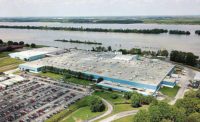Trucks moved roughly 71 percent of the nation’s freight by weight in 2016, according to the American Trucking Association. That’s 10.55 billion tons of freight or $738.9 billion in gross freight revenue. To move all that stuff around, some 34 million trucks logged more than 450 billion miles.
Among the unsung heroes behind those numbers is Bendix Commercial Vehicle Systems LLC. The company makes safety- and performance-related components for medium- and heavy-duty trucks, tractors, trailers, buses and other commercial vehicles. Its products include air compressors, air disc brakes, drum brakes, integrated modules and vibration dampers.
Bendix also produces myriad electronic components, including antilock braking systems; stability control; automatic traction control; adaptive cruise control; lane departure warning systems; and collision mitigation systems.
The company’s customers include Caterpillar, Kenworth, Navistar, Mack Trucks, Peterbilt and Volvo.
In 2005, Bendix launched production of the ADB22X air disc brake (ADB), which features a lightweight design that significantly reduces stopping distance and extends brake system life. Today, it is the North American trucking industry’s leading ADB system. This year, Bendix surpassed the 2 million unit production mark.
That sort of success has prompted significant investment in the company’s manufacturing operations. In October 2017, Bendix invested $3.8 million in its assembly plant in Huntington, IN, to launch two new production lines. The company also spent $8 million on its manufacturing campus in Acuña, Mexico, to support growing demand for solenoid valves and manifolds. In December 2014, the company spent $8.7 million to expand its assembly plant in Bowling Green, KY , and this year will invest another $10 million in capital improvements.
A core value of the company is environmental stewardship. Bendix wants to become 100 percent landfill-free by 2020; and to reduce energy consumption and carbon dioxide emissions by 10 percent by 2019, from a 2014 baseline. Both goals are in sight. In 2017, Bendix diverted more than 26 million pounds of material waste from landfill disposal. And over the past three years, Bendix has saved more than 7 million kilowatt hours—translating to a savings of over $450,000—through implementation of energy-efficiency projects.
Remanufacturing is a key part of the company’s environmental efforts. In 2017, Bendix produced more than 2 million remanufactured components. It would take more than 200 fully loaded tractor-trailers to hold all the metal components Bendix reused in the remanufacture of compressors, air dryers and brake shoes last year. Reclaiming the components helped the company avoid the equivalent purchase of more than 8,000 tons of new parts.
Recently, we met with Carlos Hungria, COO, and Mike Pogorelc, vice president of supply chain excellence, to discuss their company’s manufacturing operations.
ASSEMBLY: Mike, you’ve been with Bendix since 1995. How do your operations today compare to what they were back then?
Pogorelc: When I started, we had subassembly benches that ran autonomously to supply final assembly. We were building product in batches, and there was a lot of work in process between cells.
Bendix was just starting to embrace lean. We did value-stream mapping, and we used systematic layout planning to redesign our operation. Today, we have a streamlined, continuous flow, from the dock, into subassembly, and then final assembly.
For some product sets, we deliver just-in-time, and in sequence, to our OEM customers. All of that is controlled electronically with our ERP [enterprise resource planning] system and EDI [electronic data interchange] process. So the level of information management has really increased.
The reliability and sophistication of our quality systems has also improved tremendously.
Hungria: If you go back 25 years, customer requirements were not that stringent. Our products were mostly mechanical, and the equipment we used to make them was basic. Today, our customers want less weight, more fuel efficiency, more features and more electronics.
As a result, tolerances have become very tight, and that has driven changes in our manufacturing equipment. Some equipment we used in the past was incapable of meeting today’s tolerances. So we started changing everything from machining to assembly and especially testing. An acceptable leak rate in a valve 25 years ago is not acceptable now. Today, our customers want zero leakage. This has dramatically changed how we assemble and test our products.
At the Huntington plant, where most of our electronics are made, the process for installing and testing software on ECUs [electronic control units] has become much more sophisticated. We cannot make a software mistake. Think about it this way: If a program on your iPhone doesn’t work, it’s no big deal. If the software in a truck doesn’t work, the consequences will be much more dramatic.
ASSEMBLY: How does your company’s “zero-defect” mindset manifest itself on the assembly line?
Hungria: We make a complete range of brake valves. One of them is called a modulator valve. It is a key component of our antilock brake system. If the system detects wheel slip or wheel lock-up, the controller will activate the modulator valves to simulate a driver pumping the brakes. The controller can activate the brakes on individual wheels (or pairs of wheels), independently, and with greater speed and accuracy than a driver.
That modulator valve simply cannot fail. So on the assembly line, we do a check after every step, whether it’s inserting a diaphragm or driving screws. The line is controlled by PLCs. If any process is out of spec, the line will stop and the part will be rejected.
After assembly, the valve goes to a leak tester. Sometimes, when you exercise a complex valve for the first time, it can leak. In that case, we do a secondary test to ensure quality control and avoid a faulty part.
ASSEMBLY: How is a remanufacturing line different from a traditional assembly line?
Pogorelc: Remanufacturing is a great business. It has a great environmental impact. We are reusing cast iron, steel and aluminum components that otherwise may end up in the landfill.
In remanufacturing, the intent is to make a product that has like-new quality with used components. We try to maximize the components that we can reuse. We have dedicated employees who assess the salvageability of products, so we can maximize the material we’re getting in.
A remanufacturing line has the same high quality standards of an OE (original equipment) assembly process. The difference comes in the amount of part numbers that the line has to handle. For example, the process of remanufacturing an air compressor involves finish-grinding the journal on the shaft. We can regrind a shaft up to four times. To accommodate that removal of material, we need to use a thicker bushing. So there’s not just one part number for a bushing, there are four part numbers.
ASSEMBLY: Bendix has set big goals for reducing waste, energy consumption and carbon emissions. How are you doing?
Hungria: We want to be 100 percent landfill-free by 2020. We are between 96 and 98 percent today.
We are reducing our energy consumption. We’ve changed the lights in most of our facilities to LED lights, which last longer and consume 70 to 80 percent less energy. We have installed motion-detector light switches, which turn off automatically when no one is in the room. We are also running tests on some machines to see if there’s a benefit to switching them off when there’s a certain amount of idle time between operations. But, it’s not that easy nowadays, when we are working 24/7.
This is a cultural and generational change. The younger generation is more conscious about the environment. So it is easier being green today than 25 years ago. It is happening in a very organic way.
Pogorelc: We review our environmental metrics on a monthly basis. We look at percentage of waste diverted from the landfill. We look at the amount of wastewater we’re emitting. We even do Dumpster dives, where we look at whatever we are disposing of and see what we could recycle, reuse or
repurpose.
ASSEMBLY: How is Bendix preparing for a future of autonomous vehicles? How will that affect your assembly processes?
Hungria: Bendix is well along on the road to autonomous driving. We offer all sorts of driver-assistance technology, such as lane-departure warning systems and collision mitigation systems integrating a camera, radar and the
vehicle brakes. But there are still many issues to address, such as redundancy requirements, before autonomous driving will be a reality.
From a manufacturing standpoint, our products will have much more electronic and mechatronic content and much more sophisticated software. In our Huntington facility, we already have a special room for manufacturing and programming ECUs. In the future, these will products be produced in clean rooms in all our plants.
ASSEMBLY: Now that Bendix is getting into clean rooms and more complex manufacturing processes, will you need a different kind of employee?
Pogorelc: We will need different skill sets. A manufacturing worker is no longer somebody who can simply turn a wrench. It’s somebody who can interact with computers, tablets, PLCs and machining centers. It’s a much higher degree of technical capability. Employees also need the ability to work as a team, and they need to be open to cross-training.
We are going through a generational change in manufacturing, and their needs are different. Young people are looking for complexity and the opportunity to grow. We have started to implement developmental programs at our Huntington facility to fulfill those needs.
Hungria: In the U.S., we are well-served by technical schools, and we need to get closer to them if we are going to train a new generation of employees.
In Acuña, it’s a little more challenging, but we have started. We created a unique 180-hour light manufacturing technical course for at-risk youth in Acuña. We also helped build an advanced industrial production laboratory for a local vocational high school. And, we established a dual-education apprenticeship opportunity for select students of the school. After four weeks, they are trained in all the disciplines needed to work in our facility. At the end of the program, they are offered jobs at our facility.
That helps our community, and it helps us.




